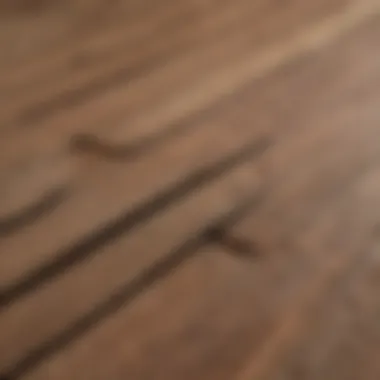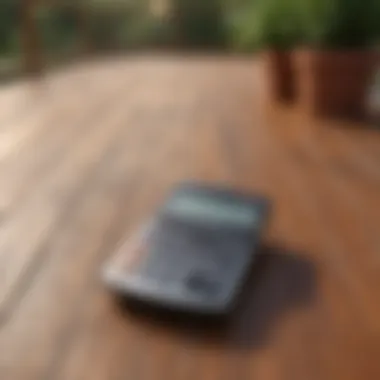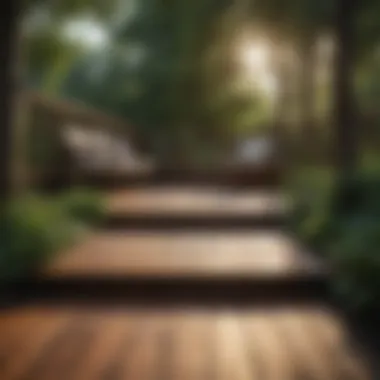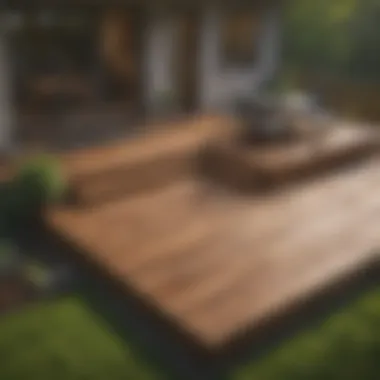Evaluating the Cost of a Pressure Treated Deck


Intro
When considering the addition of a pressure treated deck to your home, it is essential to evaluate various factors that influence the overall cost. Not only do the materials and installation contribute to the price, but regional pricing, maintenance, and design choices also play significant roles. Understanding these aspects will enable homeowners to make informed decisions that align with their budget and aesthetic preferences.
Key Components Affecting Cost
Several elements affect the cost of a pressure treated deck. Some of the most significant include:
- Material Quality: The quality of the wood used can vary, impacting durability and cost. Higher quality wood often commands a higher price.
- Installation Complexity: The deck's design can affect installation costs. A simpler rectangular design may cost less than a multi-level or intricate layout.
- Region: Geographic location varies pricing due to local demand, labor costs, and availability of materials.
- Maintenance Needs: Future upkeep, which includes sealing and potential repairs, should be factored into the long-term costs.
By examining these factors thoroughly, homeowners can better navigate the complexities related to the costs of their future decks.
Design Inspiration
Design plays a crucial role in how a pressure treated deck can augment outdoor living spaces.
Current Design Trends
In recent years, there has been a shift towards integrating outdoor areas with natural elements. Homeowners are increasingly looking for designs that promote seamless transitions between indoor and outdoor spaces. Incorporating plant containers, comfortable seating, and lighting can transform a simple deck into a stylish retreat. Natural, muted colors trend heavily, echoing the beauty of the surrounding landscape.
Color Palettes and Their Effects
Choosing the right colors for your deck can affect its visual impact and how you feel in the space. Lighter tones can make areas feel larger and airier, while richer hues can create a cozy, inviting atmosphere.
"The right choice in color can enhance the aesthetic appeal of your deck, ultimately influencing how you and your guests perceive the space."
A successful design not only looks good but also meets functional needs. It is advisable to think about how the space will be used, whether for family gatherings, parties, or quiet evenings.
Entertaining Ideas
Entertaining outdoors is one way to utilize your deck effectively. Planning your space can enhance every gathering.
Themed Party Concepts
Creating a theme for entertaining can elevate an occasion. A rustic barbecue, elegant evening, or casual garden party could all be great concepts to explore. Choosing decor elements that complement your pressure treated deck design will breathe life into your events.
Menu Planning and Recipes
The menu should align with your theme. Consider incorporating items that are easy to prepare and serve. Grilled vegetables, refreshing salads, and light desserts are excellent choices that can be enjoyed in an outdoor setting.
By focusing on design and entertaining, homeowners can maximize the value and enjoyment of their pressure treated decks.
Prologue to Pressure Treated Decks
Pressure treated decks are a popular choice among homeowners looking to enhance their outdoor living spaces. These decks provide a blend of durability and aesthetic appeal, making them suitable for various climates and uses. Understanding the cost involved in installing pressure treated decks is crucial for anyone considering this investment. The price can vary based on numerous factors including materials, labor, and regional differences.
Understanding Pressure Treatment
Pressure treatment is a method used to protect wood from rot, insects, and other damaging factors. This process involves placing wood into a chamber, where it's subjected to a vacuum that removes air. Then, a preservative is forced into the wood fibers under pressure. Because of this treatment, the wood becomes more resilient compared to untreated alternatives. Common preservatives include alkaline copper quat and copper azole, both of which enhance durability while being relatively safe for the environment.
Benefits of Pressure Treated Wood
There are several advantages to using pressure treated wood for your deck. The most notable benefits include:
- Increased Longevity: Treated wood can resist decay and insect infestation, allowing your deck to last longer with proper maintenance.
- Cost-Effective: Although the initial investment may be higher than untreated wood, the lifespan and reduced need for replacement result in lower long-term costs.
- Versatility: Pressure treated wood is suitable for a variety of climates and settings, making it an ideal choice for many homeowners.
- Aesthetic Flexibility: It can be painted or stained to match the style of your home, providing customization options.
"Pressure treated wood not only adds value to your property but also enhances the overall enjoyment of outdoor activities."
In summary, understanding pressure treated decks, their treatment process, and benefits lays the foundation for evaluating their overall cost. This knowledge will guide homeowners in making informed decisions as they navigate planning and budgeting for their deck projects.
Components Influencing Deck Cost
Understanding the components that influence the cost of a pressure treated deck is crucial for homeowners and design enthusiasts. From the materials chosen to labor costs and permits, every element plays a role in the overall financial outlay. By dissecting these components, individuals can better grasp where their money goes and how best to allocate their budgets.


Material Costs Breakdown
Types of Pressure Treated Lumber
The type of pressure treated lumber you select affects not only aesthetics but also longevity and cost efficiency. Common types include Southern Yellow Pine, Douglas Fir, and Hemlock. Southern Yellow Pine is often the most popular due to its balance of strength and cost. It is pressure treated with preservatives that offer resistance to decay and insect damage. However, it can warp over time if not properly maintained.
Key Characteristics: The treatment process enhances durability, making this lumber a viable option for outdoor use.
The unique feature of Southern Yellow Pine is its predisposition to absorb stains easily, allowing for versatile finishes. However, because it is softwood, it may dent or scratch more easily compared to hardwood alternatives.
Price Variations by Species
When discussing price variations by species, consider that different wood types have distinct market prices. For example, pressure treated Cedar is often more expensive than Pine but offers natural resistance to decay. This contrasts with more economical options, which might require more maintenance or replacement in the long term.
Key Characteristics: Each species has distinct properties, affecting both the initial costs and ongoing expenses related to maintenance.
Cedar is valued for its aesthetics and durability. However, it comes with a higher price tag initially, which can deter some homeowners.
Labor Costs for Installation
Factors Affecting Labor Rates
Labor costs can vary significantly based on a range of factors including location, experience level of contractors, and the complexity of the deck design. Urban areas typically see higher labor rates due to increased demand and cost of living.
Key Characteristics: When selecting contractors, their experience will influence both quality and cost.
Choosing seasoned professionals can result in a higher upfront cost, yet usually leads to fewer mistakes and, as a result, reduced long-term expenses. Lack of experience may lead to unsatisfactory results, which might require additional repairs.
Estimating Installation Time
Estimating installation time is essential for budgeting. A more detailed design may require additional framing or support, ultimately extending labor hours and costs. Generally, a simple rectangular deck takes less time to install, while multi-level designs are more involved.
Key Characteristics: Installation time estimates directly impact labor costs and project timelines.
Understanding this can help homeowners negotiate with contractors. Longer projects may lead to additional costs, but knowing the average installation times for various designs can help you set expectations and budget appropriately.
Permitting and Design Fees
Obtaining Necessary Permissions
Permitting is a vital component of the deck installation process. Many municipalities require specific permits to ensure that structures meet local building codes. Obtaining necessary permissions can sometimes be time-consuming and may also include application fees.
Key Characteristics: Proper permits help ensure safety and compliance with local regulations.
While obtaining permits incurs costs, failing to do so may result in fines or costly removal of non-compliant structures. Hence, allocating time and budget for this step is crucial.
Costs for Architectural Plans
In certain cases, especially with custom designs, hiring an architect or designer may be necessary. These professionals create detailed architectural plans that specify dimensions, materials, and overall design aesthetics.
Key Characteristics: Well-placed investment in architectural plans can lead to more successful execution.
Although this can represent a considerable upfront expense, having a clear, professionally designed plan can prevent issues during construction and save potential rework costs later on.
Geographic Variations in Costs
Understanding geographic variations in costs is crucial when evaluating the price of a pressure treated deck. Costs can fluctuate significantly based on location. These factors can influence both material and labor expenses. Homeowners need to be informed about these regional elements to make budget-conscious decisions.
Regional Pricing Factors
Regional Demand and Supply Dynamics
Regional demand and supply dynamics play a vital role in determining deck costs. When there is high demand for construction in an area, vendors may increase prices due to limited supply. Conversely, in regions where there is less demand, prices often lower, allowing for more favorable purchasing conditions.


This characteristic of regional demand can be beneficial for homeowners looking to install a deck, as evaluating the local market can help identify the best times to buy materials. However, it can create inconsistencies in pricing. Unforeseen spikes in demand during popular seasons may result in buyers paying more than anticipated, stressing the importance of market research.
Specific features of regional pricing dynamics include localized supply chains. If certain woods or materials are locally sourced, transport costs can decrease, impacting the overall price positively. Conversely, imported materials could drive prices up in areas where local options are scarce.
Transport Costs for Materials
Transport costs for materials also significantly affect the overall cost of a pressure treated deck. These costs vary significantly based on your location relative to manufacturers and suppliers. In areas closer to lumber mills or major distributors, these costs tend to be lower. This characteristic is beneficial for homeowners living near these supply points.
However, for those in remote areas, added transportation fees can inflate the material costs dramatically. This unique feature of transport costs serves as an important consideration for budgeting.
Besides impacting the cost directly, transport efficiency can determine delivery timelines. It may result in longer wait times for products, influencing project planning. Understanding local transport dynamics aids in evaluating the total investment in your deck project.
Local Building Codes and Regulations
Local building codes and regulations must also be factored into the cost assessment of installing a pressure treated deck. Building codes are specific to regions and are put in place to ensure safety and compliance with structural integrity.
Homeowners should be aware of the requirement for permits and inspections, which likely adds to the overall project cost. Regulations can influence decisions such as height limits, material types, and construction methods, causing variations in budget depending on location.
Average Cost Estimates
Understanding the average cost estimates for a pressure treated deck is crucial for homeowners seeking to adhere to budgets while ensuring quality and durability. The costs associated with deck construction can vary widely based on numerous factors, including size, material quality, local labor rates, and design complexity. Recognizing these elements allows individuals to make deliberate decisions that align with their financial constraints and aesthetic preferences.
Cost per Square Foot
Comparing Different Deck Sizes
When evaluating the costs of a pressure treated deck, the size is a fundamental aspect. Typically, the larger the deck, the lower the cost per square foot, due to economies of scale. This means that homeowners may find that building a larger deck can be more economical in terms of overall pricing.
Smaller decks, however, can present unique challenges. The labor effort often remains relatively constant, regardless of deck size, which can lead to a higher cost per square foot. Homeowners should consider not only the size but the layout and intended use of the deck. A well-planned smaller deck may offer the same value as a larger installation when factoring in usability and design.
Benefits of understanding size implications include:
- Better alignment with budget constraints
- Optimized use of space, enhancing overall aesthetics
- Potential for creative smaller-scale designs that can be more functional
Cost Implications of Custom Designs
Custom designs can significantly affect the total cost of a project. While they often result in a unique and tailored deck that perfectly suits one’s style and needs, they can also incur higher material and labor costs. The complexity of a custom design can lead to increased time on-site, which often translates to a steep increase in labor charges.
A key characteristic of custom designs is their ability to reflect personal tastes and accommodate various features, such as built-in seating or multi-level structures. However, it is vital for homeowners to weigh the personal value of these customizations against the additional costs incurred.
Advantages of opting for custom designs can include:
- Tailored features that fulfill specific needs
- Unique aesthetics that set your deck apart
- Enhanced property value due to custom elements
Potential disadvantages often involve:
- Higher upfront cost that may strain budgets
- Longer project timelines due to increased complexity
Typical Installation Costs
Installation costs deserve careful consideration, as they encompass more than just materials. Generally, labor makes up a significant portion of the overall cost. Deck installations can vary due to the complexity of design, local labor market conditions, and permitting hurdles that may arise during the process.
On average, homeowners can expect to spend between $15 to $30 per square foot for installation, depending on the abovementioned factors. This estimate can include additional costs for permits or fees, which can add to the total cost of the project.
In summary, being knowledgeable about average cost estimates can provide an impactful edge while budgeting for deck installation. By carefully evaluating both material and installation aspects, homeowners can ensure a smoother planning process, allowing for successful completion of their pressure treated deck that meets both their needs and aesthetic preferences.
Long-term Cost Considerations
Maintenance Costs
Re-staining and Sealing Needs
Re-staining and sealing are central to the upkeep of a pressure treated deck. These processes help protect the wood from moisture, UV rays, and general wear. Re-staining involves applying a fresh layer of stain to rejuvenate the wood's appearance. Sealing safeguards against water penetration, which can otherwise lead to rot and deterioration. These tasks are necessary every few years, depending on the product used and environmental conditions.


The key characteristic of re-staining and sealing is their preventive nature. By investing in these maintenance activities, homeowners can extend the life of their decks significantly. This is a popular choice as it prevents costly repairs and promotes durability.
However, homeowners need to be aware of the unique feature that these tasks require time and materials. The upfront costs for supplies, along with the time investment for application, may not be trivial. Yet, the advantages—such as avoiding more expensive replacements—often outweigh the initial expenses.
Effects of Weathering on Longevity
Weathering is another important aspect to consider in the longevity of a pressure treated deck. Over time, factors like sun exposure, rain, and temperature variations can cause wood to fade, crack, and warp. Understanding these effects is vital for proper maintenance planning.
The key characteristic of weathering is that it is an inevitable process. Homeowners must accept that their decks will face a range of environmental challenges. Recognizing this helps in adopting proactive measures to mitigate damage. It is beneficial as it encourages regular inspections and timely maintenance, which can ultimately extend the deck's lifespan.
Nevertheless, a unique feature of this consideration is the need for periodic assessments of the deck's condition. Not addressing the effects of weathering can lead to more significant harms that require costly repairs. Thus, striking a careful balance in maintenance efforts is essential.
Repair vs Replacement Costs
When it comes to the costs associated with maintaining a pressure treated deck, homeowners often grapple with the decision between repairing and replacing the deck. Fixing minor issues can be a cost-effective way to prolong the deck’s usability. However, there are situations where replacement is more prudent.
Repair costs might seem smaller initially. Simple fixes like replacing a few boards or reapplying sealant can keep a deck in good shape for limited years. Yet, as damage accumulates over time, the cumulative costs of multiple repairs may end up being more than a complete replacement.
In contrast, while the upfront cost for replacement is high, it might result in a longer-lasting structure that requires less recurring expense. Evaluating the overall condition of the deck, alongside potential future costs, is essential for making an informed decision.
The investment in maintenance and planned repairs is crucial for maintaining a pressure treated deck, rather than waiting for issues to escalate.
Overall, understanding the long-term cost considerations ensures that homeowners carefully evaluate their choices for maintaining their pressure treated decks in terms of budget and practicality.
Financing Options for Deck Projects
Financing options for deck projects are critical in the overall decision-making process for homeowners. Building a pressure-treated deck is often a significant investment, and understanding how to finance this project can ease the financial burden. This section explores various financing approaches, focusing on their specific elements, benefits, and key considerations.
Home Improvement Loans
Home improvement loans have become a popular choice for homeowners looking to enhance their outdoor spaces. These loans specifically cater to renovations and upgrades like installing a pressure-treated deck. They can cover not only the cost of materials but also labor expenses.
- Types of Loans:
- Personal Loans: Unsecured loans that can provide lump sums which can be repaid over time.
- Home Equity Loans: Loans based on the equity in a home, often with lower interest rates and fixed payments.
- Home Equity Line of Credit (HELOC): Offers a revolving line of credit which homeowners can draw upon as needed.
Each of these loans can help manage the upfront costs associated with building a new deck. Rates and terms depend on individual credit scores and the financial institutions involved. It is prudent for homeowners to shop around for the best rates and terms available.
Contractor Payment Plans
Contractor payment plans offer an alternative way for homeowners to finance deck construction without taking out loans. Many contractors provide flexible payment options, allowing clients to pay over time as the project progresses.
- Payment Structures:
- Installment Payments: Payments spread over different stages of the project (e.g., initial deposit, midpoint, and final payment).
- Deferred Payments: Homeowners may be allowed to delay payments for a certain period, providing financial relief in the short term.
Choosing a contractor that offers payment plans can significantly lower the financial stress. Homeowners should clarify all terms and conditions before proceeding to ensure there are no hidden fees. The method of financing chosen will ultimately have a considerable impact on the overall costs and homeowners' budgeting strategies.
"Strategic financing can maximize the value of your investment in a pressure-treated deck while keeping your budget intact."
Exploring these financing options, whether through loans or contractor payment plans, ensures that homeowners can pursue their ideal deck additions without compromising financial security.
Epilogue
In the context of building a pressure treated deck, the conclusion serves a meaningful purpose. It synthesizes the key points discussed throughout the article, providing a clear overview that helps homeowners grasp the complexities involved in deck installation. Understanding the cost implications of material selection, labor, and maintenance is vital for effective budgeting.
Recap of Key Points
When considering a pressure treated deck, several aspects stand out:
- Material Costs: The type of pressure treated lumber significantly affects overall pricing.
- Labor Costs: Installation rates can fluctuate based on location and contractor expertise, impacting the final expense.
- Maintenance Needs: Regular upkeep, such as staining or sealing, should factor into total cost assessments.
- Geographic Variation: Regional pricing and local building codes can influence both material costs and labor fees.
Recognizing these points informs better decision-making and helps homeowners anticipate future expenses.
Final Thoughts on Budgeting for a Deck
Budgeting for a pressure treated deck requires careful consideration. Evaluate not just the initial outlay for materials and installation but also the long-term financial commitments arising from maintenance and repairs. Homeowners should be vigilant about selecting reputable contractors who provide transparent quotes. Every detail, from the kind of wood to local building regulations, contributes to the total cost.
Taking the time to assess all these elements leads to a well-planned project, ensuring the end result balances aesthetics and functionality without overstretching financial boundaries. A pressure treated deck not only enhances outdoor living space but also serves as an investment that, if well-maintained, can provide joy for years.















